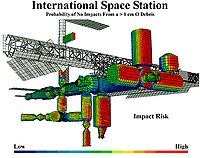
Photo from wikipedia
Major accidents are complex, multi-attribute events, originated from the interactions between intricate systems, cutting-edge technologies and human factors. Usually, these interactions trigger very particular accident sequences, which are hard to… Click to show full abstract
Major accidents are complex, multi-attribute events, originated from the interactions between intricate systems, cutting-edge technologies and human factors. Usually, these interactions trigger very particular accident sequences, which are hard to predict but capable of producing exacerbated societal reactions and impair communication channels among stakeholders. Thus, the purpose of this work is to convert high-dimensional accident data into a convenient graphical alternative, in order to overcome barriers to communicate risk and enable stakeholders to fully understand and learn from major accidents. This paper first discusses contemporary views and biases related to human errors in major accidents. The second part applies an artificial neural network approach to a major accident dataset, to disclose common patterns and significant features. The complex data will be then translated into 2-D maps, generating graphical interfaces which will produce further insight into the conditions leading to accidents and support a novel and comprehensive “learning from accidents” experience.
Journal Title: Safety Science
Year Published: 2017
Link to full text (if available)
Share on Social Media: Sign Up to like & get
recommendations!